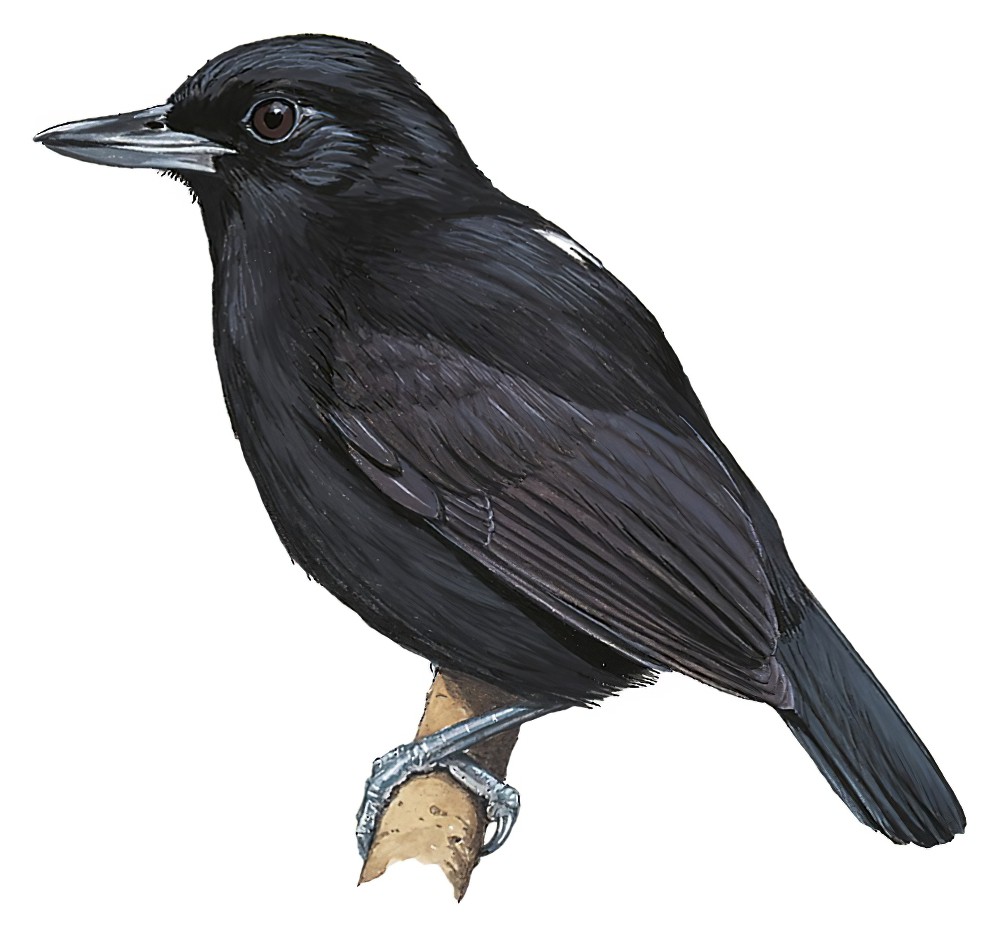Black Bushbird / Neoctantes niger

Black Bushbird
SCI Name:
Protonym: Xenops niger Sitz.K.Akad.Wiss.Wien 34 p.111
Taxonomy: Passeriformes / Thamnophilidae / Neoctantes
Taxonomy Code: blabus1
Type Locality: Marabitanas, Rio Negro, Brazil.
Author: von Pelzeln
Publish Year: 1859
IUCN Status: Least Concern
DEFINITIONS
NEOCTANTES
(Thamnophilidae; Ϯ Black Bushbird N. niger) Gr. νεος neos new, strange; κταντης ktantēs murderer (i.e. antshrike) < κτεινω kteinō to murder; "2. NEOCTANTES NIGER. ... This singular bird was originally described by Herr von Pelzeln as a Xenops, under the designation which it had received in Natterer's MS. In his recently published 'Ornithologie Brasiliens,' Herr von Pelzeln has removed it to the genus Pteroptochus; but a glance at the structure of the nostrils (which have no traces of the characteristic operculum of the Pteroptochidae) is sufficient to show that this is not its natural position. For myself, I believe that it may be correctly removed to the Thamnophilinæ, with which it agrees in general structure, but that it must stand as the type of a new genus in the neighbourhood of Thamnistes, which I propose to call Neoctantes*. Neoctantes genus novum Thamnophilinarum. Habitus generalis Thamnophili, sed rostro compresso, subrecurvato differt. Nares patulæ. Culmen rectum, subdescendens, ad apicem paulum incurvum. Tomiarum linea parum ascendens. Gonys recurvus fortiter ascendens. Alæ breves, remigibus quinto sexto et septimo inter se fere æqualibus et longissimis. Pedes sicut in speciebus minoribus generis Thamnophili. Typus et species unica N. niger. ... *νεος (novus) et κταντης (occisor)." (P. Sclater 1869).
niger
L. niger black, dark coloured, shining black, jet black (cf. ater dead black, dusky) (see nigra).
● ex “Black Vulture” of Willughby 1676, and Latham 1781, “Swarthy Vulture” of Charleton 1677, “Vultur niger” of Brisson 1760, and “Avoltojo nero” of Cetti 1776 (syn. Aegypius monachus).
● ?ex “Bouvreuil noir d’Afrique” of Brisson 1760 (Bubalornis).
● ex “Black Hawk” of A. Wilson 1812 (syn. Buteo lagopus sanctijohannis).
● ex “Barbu de Cayenne” of d’Aubenton 1765-1781, pl. 206, fig. 1 (Capito).
● "70. STERNA. ... nigra. 3. S. cauda subforficata, corpore cano, capite rostroque nigro, pedibus rubris. Fn. svec. 128. Hirundo marina minor. Alb. av. 2. p. 82. t. 89. Sterna fusca. Raj. av. 131. Larus cinereus minor. Aldr. orn. . . Habitat in Europa; vivit in societate." (Linnaeus 1758) (Chlidonias).
● ex “Martinet de S. Domingue. Hirundo apus dominicensis” of Brisson 1760, and “Petit Martinet noir” of de Buffon 1770-1783 (Cypseloides).
● ex “Ibis of Bellonius” of Willughby 1676, and Ray 1713, “Ibis” of Brisson 1760, “Ibis noir” of de Buffon 1770-1783, and “Black Ibis” of Latham 1785 (syn. Geronticus calvus).
● ex “Black Snipe” of Pennant 1785, and Latham 1785 (syn. Haematopus bachmani).
● ex “Black Rail” of Latham 1785 (syn. Limnocorax flavirostris).
● “Vieillot [1817] probably referred to this species, but the brief description might equally apply to P. fuscicollis” (Ogilvie-Grant 1898) (Microcarbo).
● ex “Yellow-tufted Bee-eater” of Latham 1782 (syn. Moho nobilis).
● ex “Barbu à gorge noires” of de Buffon 1770-1783, “Barbu de l’ile de Luçon” of Sonnerat 1782, and “Black-throated Barbet” of Latham 1782 (syn. Notharchus tectus).
● ex “Mésange Noire” of Levaillant 1803, pl. 137 (Melaniparus).
● ex “Black Shrike” of Latham 1781 (Platypsaris).
● ex “Pluvian du Sénégal” of d’Aubenton 1765-1781, pl. 918 (syn. Pluvianus aegyptius).
● ex "Troupiale noir de Saint-Domingue" of d'Aubenton 1765-1781, pl. 534 (Quiscalus).
● ex "Icterus niger" of Brisson 1760, "Troupiale noir" of de Buffon 1770-1783, and "Black Oriole" of Latham 1782, and Pennant 1785 (syn. Quiscalus niger).
● "60. TROCHILUS. ... niger. 13. T. rectricibus subæqualibus, corpore nigro subtus aurato, ano albo. Trochilus niger. Mus. Ad. Fr. I. p. 13. Habitat in Indiis." (Linnaeus 1758) (describing a melanistic form of this variable species) (Threnetes).
● "52. CUCULUS. ... niger. 6. C. cauda cuneiformi, corpore nigro nitido, rostro flavo. Cuculus indicus niger. Edw. av. 58. t. 58. Habitat in Benghala." (Linnaeus 1758) (unident.).
UPPERCASE: current genus
Uppercase first letter: generic synonym
● and ● See: generic homonyms
lowercase: species and subspecies
●: early names, variants, mispellings
‡: extinct
†: type species
Gr.: ancient Greek
L.: Latin
<: derived from
syn: synonym of
/: separates historical and modern geographic names
ex: based on
TL: type locality
OD: original diagnosis (genus) or original description (species)












